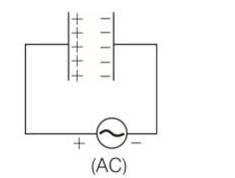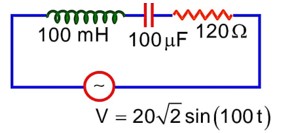Alternating Current
Get insights from 92 questions on Alternating Current, answered by students, alumni, and experts. You may also ask and answer any question you like about Alternating Current
Follow Ask QuestionQuestions
Discussions
Active Users
Followers
New answer posted
4 months agoContributor-Level 10
This is a multiple choice answer as classified in NCERT Exemplar
(a, d) For house hold supplies, AC currents are used which are having zero average value over a cycle.
The line is having some resistance so power factor cos φ = R/Z≠0
so, φ not equal to π /2 ⇒ φ < /2
i.e., phase lies between 0 and π /2.
New answer posted
4 months agoContributor-Level 10
This is a multiple choice answer as classified in NCERT Exemplar
(c, d) When the AC voltage is applied to the capacitor, the plate connected to the positive terminal will be at higher potential and the plate connected to the negative terminal will be at lower potential.

The plate with positive charge will be at higher potential and the plate with negative charge will be at lower potential. So, we can say that the charge is in phase with the applied voltage.
P= ErmsIrmscos
=90
So power, P = 0
New answer posted
4 months agoContributor-Level 10
This is a multiple choice answer as classified in NCERT Exemplar
According to the question power transferred Is P = I2 Z cos?
as we know cos? = R/Z
R>0 and Z>0
cos? >0 so P>0
New answer posted
4 months agoContributor-Level 10
This is a multiple choice answer as classified in NCERT Exemplar
We have to transmit energy (power) over large distances at high alternating voltages, so current flowing through the wires will below because for a given power (P).
P= ErmsIrms, Irms is low when Erms is high.
Power loss= I 2 rms R= low
New answer posted
4 months agoContributor-Level 10
This is a multiple choice answer as classified in NCERT Exemplar
(c, d) According to the question, the current increases on increasing the frequency of supply. Hence, the reactance of the circuit must be decreases as increasing frequency.
For a capacitive circuit, capacitive reactance Xc=
For an CR circuit Z= when frequency increases X decreases.
Taking an Exam? Selecting a College?
Get authentic answers from experts, students and alumni that you won't find anywhere else
Sign Up on ShikshaOn Shiksha, get access to
- 65k Colleges
- 1.2k Exams
- 687k Reviews
- 1800k Answers

